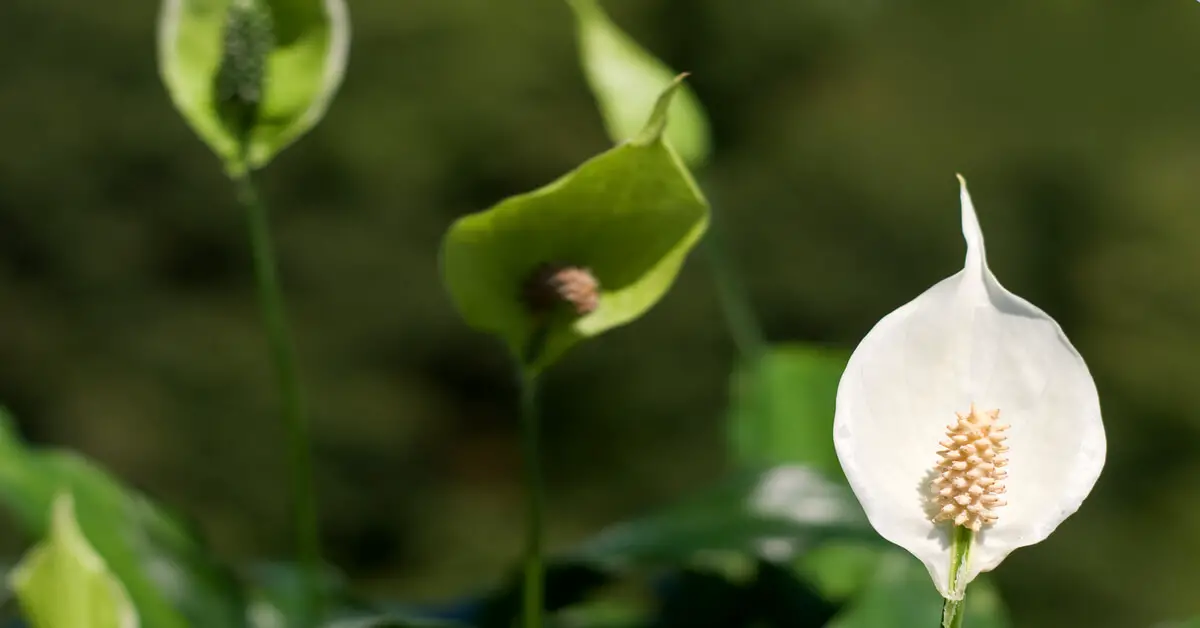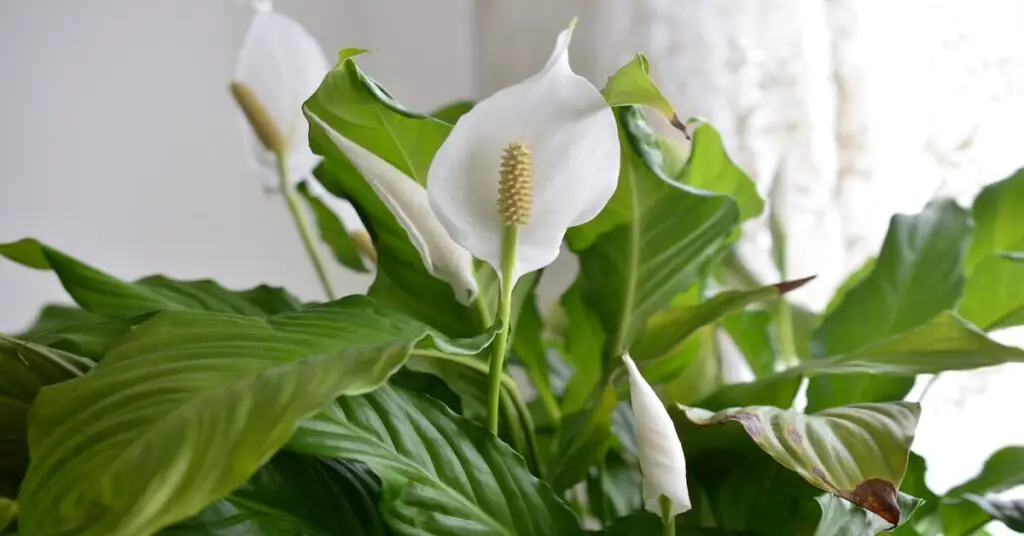Spathiphyllum, commonly known as peace lily, is a flowering plant from the Araceae family. The plant has more than 40 species and is native to tropical regions of South and Central America.
The popular houseplant often has gorgeous white flowers with broad glossy green foliage. It also goes by the names of white sails and spathe flower.
Peace Lily Care
Peace lilies are fantastic for beginners to advanced houseplant growers. They need moderate care.
If you want to own or grow a peace lily, find everything you need to know about its care below!
Soil
Spathe flowers need free-draining soils and pots. It is also best to ensure soil moisture levels are moderate and not over-saturated.
Watering
As stated above, the soil moisture level should remain moderate. You can ensure this by allowing the top inch or two of soil to dry between waterings. If the soil dries any further, it can cause the leaves to turn yellow and wilt. Room temperature water is best for the white sail.
Lighting
Peace lilies should receive bright but indirect lighting. The plant can tolerate low-lighting conditions. But they are not optimal for growth and can cause flowers not to bloom. If placed in direct lighting, the sun will scorch the leaves.
Humidity & Temperature
This plant will flourish in temperatures between 68°F to 85°F or (20°C to 29.4°C). Temperatures below 60°F or 15.56°C have the potential to cause cold damage. White sail plants love moisture and require humidity levels of around 75%.
Fertilizing
These lilies need minimal fertilizer. Only needing a 20-20-20 liquid houseplant fertilizer every six to eight weeks. When growing in the spring and summer. The fertilizer should not be full-strength. Dilute to one-quarter of the suggested amount on the fertilizer’s packaging. Over-fertilization can turn the edges of the foliage brown and burn roots.
Propagation
You can propagate a spathe flower through division. This process involves removing the plant from its pot and soil. Once the plant is free, carefully pull apart a root section containing several leaves. Then use a gardening blade to thoroughly remove the section from the mother plant and other roots. Lastly, place your cut section into a free-draining soil and pot.
Diseases & Pests
Common houseplant pests can affect spathe flowers. Including scales, mealybugs, fungus gnats, and spider mites. Discoloration or speckling in the leaves can be a sign of spider mites.
Due to overwatering, root rot and other root and stem diseases are common. Magnesium deficiency can also be a problem for the plant and stunt growth.
Toxicity
A peace lily’s plant cells contain calcium oxalate crystals. Which are toxic to humans and animals. When ingested, it can cause a burning sensation in the mouth, tongue, and throat. It is best to keep the plant out of the reach of children and animals.
Peace Lily Benefits
It is beneficial to grow spathe flowers or peace lilies indoors. Because they have air-purifying abilities. The white flower plant can remove formaldehyde, benzene, Trichloroethylene, xylene, toluene, and ammonia from the air. And subsequently improve indoor air quality [1]. These compounds can be toxic and lead to health complications.
Peace Lily Meaning & Symbolism
The peace lily or white sail plant carries a meaning and symbolism of purity. That is because of its white flowers. Many plants with white flowers also hold this meaning.
Peace Lily Flower Stages

Peace lilies have four flowering stages. Including flower buds, flowering, production of seeds, and the final stage.
Stage one, flower buds, can simply look like new foliage. But the spathe of the budding flower is a modified leaf that protects the spadix.
Stage two, flowering, the spathe opens up and exposes the spadix. That is when we get to see the classic white peace lily blooms.
Stage three, production of seeds, happens after its flowers have been pollinated. The flowers close and turn into a small structure that looks like berries. The spadix will also darken. This process may cause the spathe to wilt. Gardeners often remove the wilting spathes. So, the plant can use the energy to grow leaves and new flowers.
In stage four, the final stage, the flowers will wilt and die. While dying, the flowers will spread seeds as they drop from the spadix.
Growing Peace Lilies Indoors & Outdoors
Peace lilies are often grown as houseplants, but you can also grow them outdoors in zones 10 and 12. When growing outdoors, they have to be planted in the shade with indirect light.
Peace Lily with Brown Tips on Leaves
Many varieties of spathe flower have brown tips on the leaves when it is over-fertilized. To prevent over-fertilization, flush out the soil if you accidentally apply too much fertilizer.
Types of Peace Lilies
There are many species and cultivators of peace lilies. Many varieties of the plant are from tropical regions of South and Central America. Tropical plant cultivators have also ushered in many new types of the original plant. To date, there are more than 40 species of the plant. Below are some of the most popular varieties.
- Sensation is a large variety of Spathiphyllum that can reach 6″ in height and has large leaves.
- Jetty has glossy green elephant ear-style leaves and white flowers.
- White Stripe peace lilies have a white strip that grows in the center of matte green leaves.
- Little Angel is a dwarf peace lily that readily blooms compared to more mature varieties.
- Start Light variety of spathe flower is a compact grower with lustrous dark green leaves.
- Domino has white streaks through its dark green foliage. It can become 30″ in height and diameter.
- Wallisii is a small variety of the plant and only reaches 12″ to 15″ in height. The blooms are also small, only growing 3″ with 8″ to 10″ green rippling leaves.
- Mauna Loa Supreme mature to 2′ to 3′ in height with 9″ long leaves attached to 10″ to 12″ stalks. The leaves reach 5″ wide with blooms that are 4″ in diameter on 15″ to 20″ long stems. It is a mid-size Spathiphyllum.
- Piccolino is another dwarf species of the plant. It has the classic glossy green foliage and white flowers.
References:
[1]Wikimedia Foundation. (2022, October 18). NASA Clean Air Study. Wikipedia. Retrieved October 31, 2022, from https://en.wikipedia.org/wiki/NASA_Clean_Air_Study


